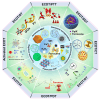Recent advances in ferrocene-based nanomedicines for enhanced chemodynamic therapy
- PMID: 39744691
- PMCID: PMC11671379
- DOI: 10.7150/thno.101697
Recent advances in ferrocene-based nanomedicines for enhanced chemodynamic therapy
Abstract
Malignant tumors have been a serious threat to human health with their increasing incidence. Difficulties with conventional treatments are toxicity, drug resistance, and recurrence. For this reason, non-invasive treatment modalities such as photothermal therapy (PTT), photodynamic therapy (PDT), chemodynamic therapy (CDT), and others have received much attention. Among them, Ferrocene (Fc)-based nanomedicines for enhanced Chemodynamic Therapy (ECDT) is a new therapeutic strategy based on the Fenton reaction. Based on ferrocene's good biocompatibility, potentiation in medicinal chemistry, and good stability of divalent iron ions, scientists are increasingly using it as a Fenton's iron donor for tumor therapy. Such ferrocene-based ECDT nanoplatforms have shown remarkable promise for clinical applications and have significantly increased the efficacy of CDT treatment. Ferrocene-based nanomedicines exhibit exceptional consistency owing to their low toxicity, high stability, enhanced bioavailability, and a multitude of advantages over conventional approaches to cancer treatment. As a consequence, a number of tactics have been investigated in recent years to raise the effectiveness of ferrocene-based ECDT. In this review, we detail the different forms and strategies used to enhance Ferrocene-based ECDT efficiency.
Keywords: Enhanced Chemodynamic therapy (ECDT); Ferrocene; Nanomedicine; Synergistic therapy.
© The author(s).
Conflict of interest statement
Competing Interests: The authors have declared that no competing interest exists.
Figures











Similar articles
-
Conjugated Polymer-Ferrocence Nanoparticle as an NIR-II Light Powered Nanoamplifier to Enhance Chemodynamic Therapy.ACS Appl Mater Interfaces. 2021 Jul 14;13(27):31452-31461. doi: 10.1021/acsami.1c06613. Epub 2021 Jul 1. ACS Appl Mater Interfaces. 2021. PMID: 34197086
-
Dual-enzyme inhibiting nanomedicines for enhanced cancer chemodynamic therapy by inducing intratumoral acidosis.Int J Pharm. 2024 Sep 30;663:124568. doi: 10.1016/j.ijpharm.2024.124568. Epub 2024 Aug 11. Int J Pharm. 2024. PMID: 39137822
-
A BODIPY-Ferrocene Conjugate for the Combined Photodynamic Therapy and Chemodynamic Therapy with Improved Antitumor Efficiency.Chemistry. 2024 Sep 19;30(53):e202401916. doi: 10.1002/chem.202401916. Epub 2024 Sep 6. Chemistry. 2024. PMID: 39023507
-
Manipulating Intratumoral Fenton Chemistry for Enhanced Chemodynamic and Chemodynamic-Synergized Multimodal Therapy.Adv Mater. 2021 Dec;33(48):e2104223. doi: 10.1002/adma.202104223. Epub 2021 Sep 27. Adv Mater. 2021. PMID: 34580933 Review.
-
Recent Advances on NIR-II Light-Enhanced Chemodynamic Therapy.Adv Healthc Mater. 2024 Apr;13(10):e2303451. doi: 10.1002/adhm.202303451. Epub 2023 Nov 27. Adv Healthc Mater. 2024. PMID: 37983596 Review.
References
-
- Sung H, Ferlay J, Siegel R L, Laversanne M, Soerjomataram I, Jemal A. et al. Global cancer statistics 2020: Globocan estimates of incidence and mortality worldwide for 36 cancers in 185 countries. CA Cancer J Clin. 2021;71:209. - PubMed
Publication types
MeSH terms
Substances
LinkOut - more resources
Full Text Sources
Medical
Research Materials

